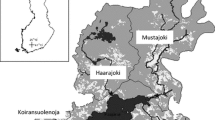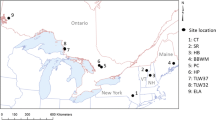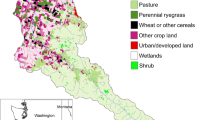Abstract
The importance of snowmelt and spring rainfall to water and nutrient exports from macro-scale watersheds (>1000 km2) is not well established. Data collected from the Androscoggin River watershed (Maine and New Hampshire) between February 1999 and March 2002 show that the 90-day spring melt period accounted for 39–57% of total annual discharge and is likely driven both by snowpack melting and spring rainfall. While large loads of dissolved inorganic nitrogen (DIN) are delivered to the watershed from snowmelt and rain (from 1.16× 106 to 1.61× 106 kg N over the study years), only one third of this N load is exported from the basin during the snowmelt period (0.40× 106–0.48 × 106 kg N). Despite reduced residence time and temperature limitations on biological N retention, there is a poor mass balance between DIN input to the watershed and the nitrogen exported from mouth of the river. Inferences from a geochemical hydrograph separation suggests that approximately 51–63% of the water leaving the mouth of the Androscoggin river is from these ‘new’ water sources (rain and snowmelt) while 37–49% is from DIN depleted soil and groundwater. Mixing of water from different sources, as well as nutrient retention by dams in the upper watershed, may account for the large discrepancy between DIN inputs and exports from this watershed.
Similar content being viewed by others
References
Alexander R.R., Troendle C.A., Kaufmann M.R., Shepperd W.D., Crouch G.L. and Watkins R. 1985. The Fraser Experimental Forest, Colorado: research program and published research 1937–1985. General Technical Report RM-118, Fort Collins, Colorado. United States Department of Agriculture, Forest Service. Rocky Mountain Forest and Range Experimental Station, 35 pp.
Anderson D.M. (1997). Bloom dynamics of toxic Alexandrium species in the northeastern, US Limnol. Oceanogr. 42:1009–1022
Boyer E.W., Goodale C.L., Jaworski N.A., Howarth R.W. (2002). Anthropogenic nitrogen sources and relationships to riverine nitrogen export in the northeastern USA. Biogeochemistry 57/58:137–169
Burns D.A. and Kendall C. 2002. Analysis of delta-15N and delta-18O to differentiate nitrate sources in runoff at two watersheds in the Catskill Mountains of New York. Water Resour. Res. 38(5): 9.1–9.12.
Creed I.F., Band L.E., Foster N.W., Morrison I.K., Nicolson J.A., Semkin R.S., Jeffries D.S. (1996). Regulation of nitrate-N release from temperate forests: A test of the N flushing hypothesis. Water Resour. Res. 32(11):3337–3354
Genereux D. (1998). Quantifying uncertainty in tracer-based hydrograph separations. Water Resour. Res. 34:915–919
Green P., Vörösmarty C.J., Meybeck M., Galloway J., Peterson B.J., Boyer E.W. (2003). Pre-Industrial and contemporary fluxes of nitrogen through rivers: a global assessment based on typology. Biogeochemistry 68(1):71–105
Groffman P.M., Holland E., Myrold D.D., Robertson G.P., Zou X. (1999). Denitrification. In: Robertson G.P., Bledsoe C.S., Coleman D.C., Sollins P. (eds). Standard Soil Methods for Long Term Ecological Research. Oxford University Press, New York, pp. 272–288
Hornbeck J.W., Bailey S.W., Buso D.C., Shanley J.B. (1997). Streamwater chemistry and nutrient budgets for forested watersheds in New England: variability and management implications. For. Ecol. Manage. 93:73–89
Howarth R.W., Billen G., Swaney A., Townsend D., Jaworski N., Lajtha K., Downing J.A., Elmgren R., Caraco N., Jordan T., Berendse F., Freney J., Kudeyarov V., Murdoch P., Zhao-Liang Z. (1996). Regional nitrogen budgets and riverine N & P fluxes for the drainages to the North Atlantic Ocean: natural and human influences. Biogeochemistry 35:75–139
Hunt C.W., Loder T. III, Vörösmarty C. (2005). Spatial and temporal patterns of inorganic nutrient concentrations in the Androscoggin and Kennebec Rivers, Maine. Water Air Soil Pollut 163:303–323
Jansson M., Anderson R., Berggren H., Leonardson L. (1994). Wetlands and lakes as nitrogen traps. Ambio 23:320–325
Jordan C.E., Talbot R.W. (2000). Direct atmospheric deposition of water-soluble nitrogen to the Gulf of Maine. Global Biogeochem. Cycles 14(4):1315–1329
Laudon H., Slaymaker O. (1997). Hydrograph separation using stable isotopes, silica, and electrical conductivity: an alpine example. J. Hydrol. 201:82–101
Lefer B.L., Talbot R.W. (1999). Nitric acid and ammonia at a rural northeastern US site. J. Geophys. Res. 104:1645–1661
Mayer B., Boyer E.W., Goodale C., Jaworski N.A., Van Breemen N., Howarth R.W., Seitzinger S., Billen G., Lajtha K., Nadelhoffer K., Van Dam D., Hetling L.J., Nosal M., Paustian K. (2002). Sources of nitrate in rivers draining sixteen watersheds in the northeastern US: isotopic constraints. Biogeochemistry 57/58:171–197
Mitchell M.J., Driscoll C.T., Kahl J.S., Likens G.E., Murdoch P.S., Pardo L.H. (1996). Climatic control on nitrate loss from forested watersheds in the northeastern United States. Environ. Sci. Technol. 30:2609–2612
Montgomery D.L., Robinson G.R. Jr., Ayotte J.D., Flanagan S.M. and Robinson K.W. 2002. Digital data set of generalized lithogeochemical characteristics of near-surface bedrock in the New England coastal basins. USGS Fact Sheet 003-02.
Nixon S.W. (2003). Replacing the Nile – are anthropogenic nutrients providing the fertility once brought to the Mediterranean by a great river? Ambio 32:30–39
Ollinger S.V., Aber J.D., Reich P.B., Freuder R.J. (2002). Interactive effects of nitrogen deposition, tropospheric ozone, elevated CO2 and land use history on the carbon dynamics of northern hardwood forests. Global Change Biol. 8:545–562
Rascher C.M., Driscoll C.T., Peters N.E. (1987). Concentration and flux of solutes from snow and forest floor during snowmelt in the West-Central Adirondack region of New York. Biogeochemistry 3:209–224
Seitzinger S.P., Styles R.V., Boyer E.W., Alexander R.B., Billen G., Howarth R.W., Mayer B., Van Breemen N. (2002). Nitrogen retention in rivers: model development and application to watersheds in the northeastern USA. Biogeochemistry 57/58:199–237
Shanley J.B., Chalmers A. (1999). The effect of frozen soil on snowmelt runoff at Sleepers River, Vermont. Hydrol. Process. 13:1843–1857
Shanley J.B., Kendall C., Smith T.E., Wolock D.M., McDonnell J.J. (2002). Controls on old and new water contributions to stream flow at some nested catchments in Vermont, USA. Hydrol. Process. 16:589–609
Shepard D. 1968. A two dimensional interpolation function for irregularly-spaced data. In: ACM National Conference Proceedings. Association for Computing Machinery, pp. 517–523.
Sickman J.O., Leydecker A.L., Chang C.C.Y., Kendall C., Melack J.M., Lucero D.M., Schimel J. (2003). Mechanisms underlying export of N from high-elevation catchments during seasonal transitions. Biogeochemistry 64:1–24
Sklash M.G., Farvolden R.N. (1979). The role of groundwater in storm runoff. J. Hydrol. 43:45–65
Soulsby C., Rodgers P.J., Petry J., Hannah D.M., Malcolm I.A., Dunn S.M. (2004). Using tracers to upscale flow path understanding in mesoscale mountainous catchments: two examples from Scotland. J. Hydrol. 291:174–196
Szilágyi F., Somlyody L., Koncsos L. (1990). Operation of the Kis–Balaton reservoir: evaluation of nutrient removal rates. Hydrobiologia 191:297–306
Uhlenbrook S., Roser S., Tilch N. (2004). Hydrological process representation at the meso-scale: the potential of a distributed, conceptual catchment model. J. Hydrol. 291:278–296
Van Breemen N., Boyer E.W., Goodale C.L., Jaworski N.A., Paustian K., Seitzinger S.P., Lajtha K., Mayer B., Van Dam D., Howarth R.W., Nadelhoffer K.J., Eve M., Billen G. (2002). Where did all the nitrogen go? Fate of nitrogen inputs to large watersheds in the northeastern USA. Biogeochemistry 57/58:267–293
Vitousek P.M., Aber J.D., Howarth R.W., Likens G.E., Matson P.A., Schindler D.W., Schlesinger W.H., Tilman D.G. (1997). Human alterations of the global nitrogen cycle: sources and consequences. Ecol. Appl. 7:737–750
Author information
Authors and Affiliations
Corresponding author
Rights and permissions
About this article
Cite this article
Oczkowski, A.J., Pellerin, B.A., Hunt, C.W. et al. The Role of Snowmelt and Spring Rainfall in Inorganic Nutrient Fluxes from a Large Temperate Watershed, the Androscoggin River Basin (Maine and New Hampshire). Biogeochemistry 80, 191–203 (2006). https://doi.org/10.1007/s10533-006-9017-7
Received:
Accepted:
Published:
Issue Date:
DOI: https://doi.org/10.1007/s10533-006-9017-7




